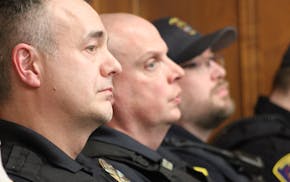Opinion editor's note: Strib Voices publishes a mix of guest commentaries online and in print each day. To contribute, click here.
•••
In a quiet classroom after school, we huddled around glowing laptops, surrounded by whiteboards filled with our ideas. That room, part of an all-girls coding club, was where we first fell in love with computer science.
It wasn't so much about the lines of code as it was the friendships we built. When you're 11 and the single biggest challenge in your day is making a tic-tac-toe game, you're not really thinking about what if-else statements make your program run — you're thinking about the high-fives and the eruption of laughter that comes when it finally works. But in those moments, we were also solving problems that felt real. We discovered that with nothing but logic and a little bit of perseverance, we could really make something. And day after day, those afternoons changed the courses of our lives.
But when we got to high school, something changed. The once-inviting community we cherished felt like it had suddenly disappeared. We were now among only four girls in our AP Computer Science A class, and it didn't feel like that was going to change anytime soon. Both of our fingers combined couldn't count the number of girls we knew who "kind of wanted to join robotics," but felt intimidated by how it was "almost all guys in there." We tried to convince some of our friends to join, but most of them were extremely hesitant — they didn't want to be known as the "girl in the room who didn't know anything."
And we don't blame them. This shift in atmosphere wasn't unique to our school; it reflects a much larger issue in STEM, one that begins as early as elementary school. When students — especially girls — say "I can't join. I've never coded before," what they're really saying is: "I don't think this is for me." And often, it's because they were never given the space to explore early on. These early gaps in education can also mean that by the time students are given the opportunity to learn, they're already behind, and they know it.
State funding for computer science can start to change that, but unfortunately the most recent state budget proposal cuts all support for computer science education. We are worried that, without state investment, we will continue to face enthusiasm gaps and participation barriers that will prevent students from reaching their full potential. These are big challenges, and they deserve statewide emphasis. Funding computer science means we can begin to even out the playing field so that all students have the same opportunity to feel at home in computer science.
Computer science has opened so many doors for us, from leading our community to pursuing advanced research. In a world where artificial intelligence is rapidly changing every industry, we feel confident in our ability to adapt and thrive. Yet, without the support and crucial funding that our public education system and computer science programs need, far too many students won't get that same chance. The next great innovator may be a girl who never felt welcome, or a boy who never got the chance to start. We owe it to them to change that.
Zhoujinyi (Jenny) Wen and Abigail Childs are seniors at Jefferson High School in Bloomington.

Olson's Cheers & Jeers: International Falls City Council wisely changes course
Opinion: 'Grease' at Chanhassen Dinner Theatres shows why we need to rethink nostalgia

Opinion: We're high school seniors, and coding changed our lives

